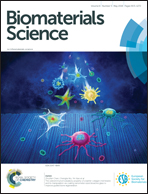Regulating the local pH level of titanium via Mg–Fe layered double hydroxides films for enhanced osteogenesis†
Abstract
Hard tissue implant materials which can cause a suitable alkaline microenvironment are thought to be beneficial for stimulating osteoblast differentiation while suppressing osteoclast generation. To make the local pH around the interface between materials and cells controllable, we prepared a series of Mg–Fe layered double hydroxide (LDH) films on acid-etched pure titanium surfaces via hydrothermal treatment. By adjusting the Mg/Fe proportion ratio, the interlayer spacing of Mg–Fe LDHs was regulated, making their OH− exchange abilities adjustable, and this ultimately resulted in a microenvironment with a controllable pH value. In vitro experiments demonstrated that the Mg–Fe LDH film-modified titanium surface possessed good biocompatibility and osteogenic activity, especially the Mg–Fe LDH film with Mg/Fe proportion ratio of 4, which could form a suitable alkaline microenvironment for the growth and osteogenetic differentiation of stem cells. These results demonstrate the potential application of the prepared Mg–Fe LDH films in enhancing the osteogenesis of implant materials while providing a new way into the design of controllable alkaline environment.



 Please wait while we load your content...
Please wait while we load your content...